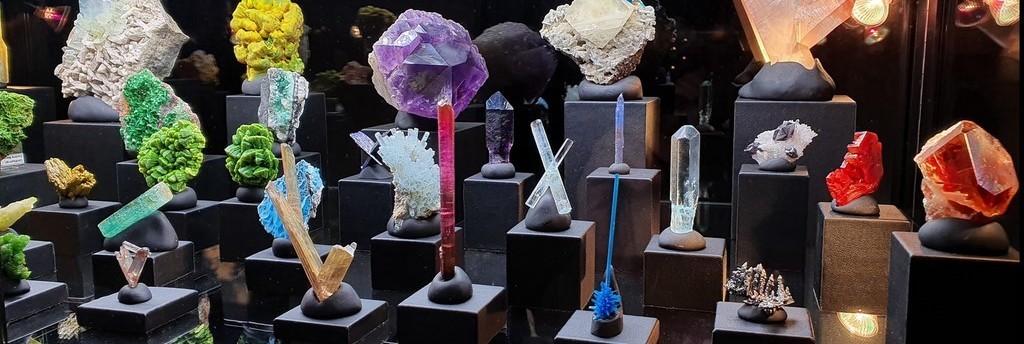Why collect minerals ?

Collecting minerals has been an activity that has been practiced for centuries by enthusiasts from all walks of life, whether they are scientists, amateurs or simply fascinated by the natural beauty of stones. Behind this activity lies a wealth that goes far beyond simple aesthetic pleasure. Collecting minerals offers a gateway to the world of Earth sciences, but also a direct link to the geological history of our planet. We will explore the different reasons that push many people to collect minerals, including educational, scientific, aesthetic and sometimes even therapeutic aspects...
Understanding the Earth and its geological history

Collecting minerals allows enthusiasts to delve into geology and mineralogy, the sciences that study the formation, structure and composition of the elements that make up our planet. Minerals are indeed the fundamental constituents of rocks, and each specimen tells a part of the geological history of the Earth. For example, a quartz crystal may have formed millions of years ago under specific pressure and temperature conditions, reflecting a unique geological episode. Geologists often collect minerals to study their origin and the conditions of their formation. For example, the discovery of certain specific minerals can reveal valuable information about the evolution of mountains, the formation of oceans, or even the history of volcanic eruptions. In addition, by studying minerals, researchers can discover deposits of natural resources such as iron, copper, zinc, or rare earths, essential for modern industries.
Hands-on and fun learning
Collecting minerals is also an ideal activity to acquire scientific knowledge in a hands-on and interactive way. Unlike other fields of science, mineralogy allows for the direct handling of specimens, facilitating learning. Each mineral has unique physical characteristics, such as hardness, cleavage, color, and fluorescence, which can be studied to better understand their classification and identification.
For young collectors or students, mineral collecting can serve as an educational tool, allowing them to understand complex concepts such as crystallography or mineral chemistry. For example, the Mohs scale, used to measure the hardness of minerals, is a fundamental tool that collectors quickly learn to use, providing a concrete way to apply scientific theories.
An aesthetic and sensory journey
The aesthetic aspect of mineral collecting is one of the main reasons why so many people are passionate about this activity. Minerals are natural works of art, with bright colors, elegant crystalline shapes, and complex structures. Collectors often seek out rare and unique specimens. This quest for objects of natural beauty gives mineral collections an aesthetic dimension comparable to that of art collecting, with each specimen being unique in its shape and appearance.
A historical and human aspect

Collecting minerals also means perpetuating the memory of a mining heritage that is most often lost, particularly in France. Some samples bear witness to past underground riches accompanied by a real human or scientific history, the labels and documents accompanying them then taking on a historical dimension. The collection also contributes to a journey through many cultures, the minerals being collected from all over the planet. It is a passport to international exchanges that are enriching on a personal level and bring a broader open-mindedness. It also allows us to better understand the distribution of resources on our planet and therefore to better understand certain geopolitical issues.
A financial investment

Some people collect minerals for their financial value. Some specimens, due to their rarity, purity or size, can have a significant value on the collectors' market. Precious stones such as diamonds, emeralds and sapphires are obvious examples of minerals with a high market value. However, even some lesser-known but rare minerals, such as tanzanite or alexandrite, can reach considerable prices, and mineral collecting can become a form of long-term investment.
Therapeutic and Symbolic Properties
Many people collect minerals for their spiritual and therapeutic properties. Although these aspects are not scientifically proven, lithotherapy (the use of stones and crystals to heal or balance energies) has gained popularity in recent years. Minerals such as amethyst, labradorite or turquoise are often used to promote meditation, reduce stress or attract positive energies. Some collectors therefore focus on stones that they consider to be beneficial on an emotional or spiritual level.
Belonging to a community
Collecting minerals also offers the opportunity to belong to a community of enthusiasts, to share discoveries and exchange knowledge. Collectors often participate in mineral fairs, exhibitions or mineralogy clubs, where they can meet people with similar interests. This strengthens a sense of belonging and creates bonds around a common passion for nature and the beauty of stones.
Collecting minerals is more than just a hobby. It is an activity that combines scientific learning, aesthetic appreciation, and personal development. Whether exploring the history of the Earth, expanding one’s scientific knowledge, or simply enjoying the natural beauty of crystals, mineral collecting offers a wealth of possibilities. For some, it is a gateway to disciplines like geology; for others, it is an aesthetic and spiritual journey.
References :
Sinkankas, J. (1993). Mineralogy: A First Course. Van Nostrand Reinhold.
Mitchell, R. S. (1979). Introduction to Mineralogy. W. H. Freeman and Company.
Schumann, W. (2008). Gemstones of the World. Sterling Publishing.
Mann, J. (2004). The Stone of Light: The Secret of the Crystal. Thames & Hudson.
